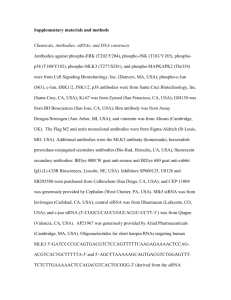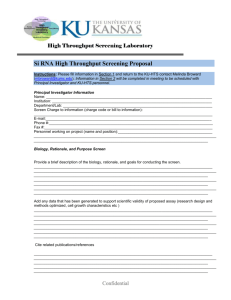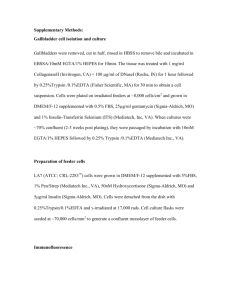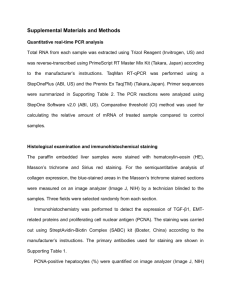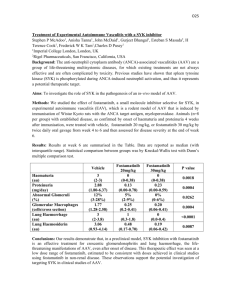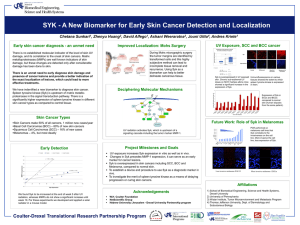References
advertisement
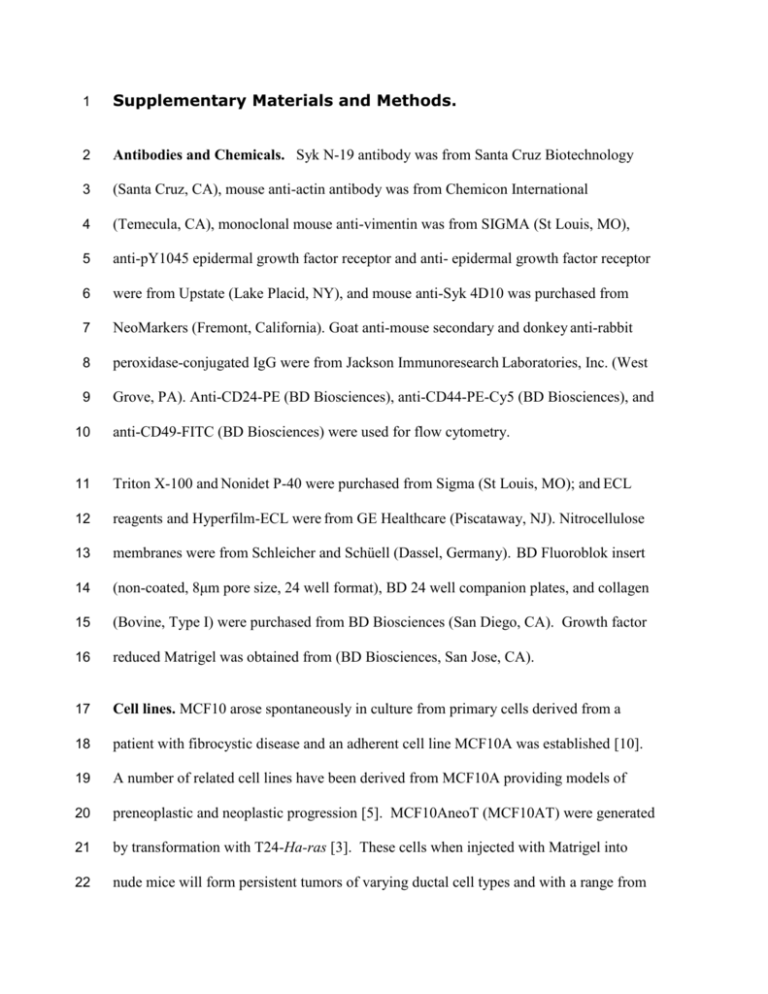
1 Supplementary Materials and Methods. 2 Antibodies and Chemicals. Syk N-19 antibody was from Santa Cruz Biotechnology 3 (Santa Cruz, CA), mouse anti-actin antibody was from Chemicon International 4 (Temecula, CA), monoclonal mouse anti-vimentin was from SIGMA (St Louis, MO), 5 anti-pY1045 epidermal growth factor receptor and anti- epidermal growth factor receptor 6 were from Upstate (Lake Placid, NY), and mouse anti-Syk 4D10 was purchased from 7 NeoMarkers (Fremont, California). Goat anti-mouse secondary and donkey anti-rabbit 8 peroxidase-conjugated IgG were from Jackson Immunoresearch Laboratories, Inc. (West 9 Grove, PA). Anti-CD24-PE (BD Biosciences), anti-CD44-PE-Cy5 (BD Biosciences), and 10 anti-CD49-FITC (BD Biosciences) were used for flow cytometry. 11 Triton X-100 and Nonidet P-40 were purchased from Sigma (St Louis, MO); and ECL 12 reagents and Hyperfilm-ECL were from GE Healthcare (Piscataway, NJ). Nitrocellulose 13 membranes were from Schleicher and Schüell (Dassel, Germany). BD Fluoroblok insert 14 (non-coated, 8μm pore size, 24 well format), BD 24 well companion plates, and collagen 15 (Bovine, Type I) were purchased from BD Biosciences (San Diego, CA). Growth factor 16 reduced Matrigel was obtained from (BD Biosciences, San Jose, CA). 17 Cell lines. MCF10 arose spontaneously in culture from primary cells derived from a 18 patient with fibrocystic disease and an adherent cell line MCF10A was established [10]. 19 A number of related cell lines have been derived from MCF10A providing models of 20 preneoplastic and neoplastic progression [5]. MCF10AneoT (MCF10AT) were generated 21 by transformation with T24-Ha-ras [3]. These cells when injected with Matrigel into 22 nude mice will form persistent tumors of varying ductal cell types and with a range from 23 hyperplasia, to atypical hyperplasia, DCIS and eventually invasive carcinoma. The stem- 24 cell-like features of these cells have been noted [3] and the MCF10AneoT cells have the 25 interesting property of expressing functional estrogen receptors in contrast to the parent 26 MCF10A cells which are ER negative [for review see [5]]. Following multiple passage 27 and selection in animals, one clone with comedo-DCIS morphology following tumor 28 formation was isolated, the DCIS.com line [8]. 29 Whole mount staining and histological analysis. For whole mount analysis, mammary 30 glands were removed and spread onto glass slides, fixed with 100% ETOH/glacial acetic 31 acid (3:1) fixative and stained with carmine alum, dehydrated, cleared in xylene, and 32 mounted with Permount. Whole mounts were examined and photographed under a stereo 33 fluorescence microscope (Nikon SMZ1500) or using multiphoton microscopy (see 34 below). For histological analysis, mammary glands were fixed in 10% buffered formalin 35 (3.7% formaldehyde), embedded in paraffin, sectioned, and stained with hematoxylin and 36 eosin (H&E) or double immunostained using anti-keratin 14 and anti-Ki67 antibodies 37 followed by fluorescent secondary antibodies and counterstained with DAPI. 38 39 Western blot analysis. The following method was used in the extraction of protein from 40 both the mammary gland (after removal of the lymph node) and spleen. In each case, the 41 sample tissue was homogenized using 1.0 ml of RIPA buffer supplemented with 42 complete protease inhibitor tablet (Roche Diagnostics) (Radioimmunoprecipitation assay 43 (RIPA) buffer: 50 mM Tris (pH 8.0), 0.1% SDS, 1% NP40, 0.5% deoxycholate, 150 mM 44 NaCl) and centrifuged at 4C for 10 min to remove tissue and cell debris. Polypeptides 45 were separated using 4 - 20% Tris-HCl Criterion TM Precast Gels (Bio-Rad 46 Laboratories, Hercules, CA) and run until the samples reached the bottom of the gel. The 47 polypeptides were transferred to a nitrocellulose membrane, blocked in 5% dry milk in 48 PBS and incubated in primary anti–Syk antibody (N-19, 1: 200 dilution, rabbit polyclonal 49 IgG, Santa Cruz Biotechnology) or mouse anti-Syk 4D10 (1:2000) followed by 50 secondary HRP-conjugated antibody. The blots were developed, imaged, and then 51 stripped and immunostained with antibodies against alpha-actin as loading controls. 52 53 Syk siRNA transfection and culture on collagen. A pool of Syk small interfering RNA 54 (siRNA) duplexes were designed to target human Syk (accession no. NM_003177; 55 Ambion, Austin, TX). As a negative control, cells were transfected with a nonspecific 56 siRNA pool (Dharmacon, Lafayette, CO). All siRNA transfections were done with 57 Lipofectamine 2000 (Invitrogen, Carlsbad, CA). MCF10A cell lines were seeded in 58 complete medium at 40-50% confluency in a six well plate and incubated at 37 oC 59 overnight. The next morning, a confluency of 70-75% was reached. siRNA was diluted to 60 250l with OPTIMEM for each transfection (Invitrogen). Lipofectamine 2000 was pre- 61 equilibrated by diluting 10l of Lipofectamine 2000 to 250l with OPTIMEM. Then, 62 0.5 ml containing both DNA and liposome complex was added and the plate was gently 63 swirled for uniform mixing. After 6 hrs, the media was replaced with 2.5 ml of complete 64 medium. The plate was incubated for 48 hrs at 37 oC and cells were collected using 65 trypsin and then washed in complete medium. Cells were placed on a layer of bovine 66 collagen gel (3.0 mg/ml) or on plastic tissue culture dishes without collagen and cultured 67 for an additional 20 hrs at 37 oC. 68 69 MTS assay. The MTS assay is composed of solutions of a tetrazolium compound (3-(4, 70 5-dimethylthiazol-2-yl)-5-(3-carboxymethoxyphenyl)-2-(4-sulfophenyl)-2H-tetrazolium, 71 inner salt; MTS) and an electron coupling reagent (phenazine methosulfate; PMS). MTS 72 is bioreduced by cells into a formazan product that is soluble in tissue culture medium. 73 Optical density (OD) in the absorbance of the formazan at 490nm was measured as an 74 indicator of cell proliferation. 75 76 Matrigel assay. Growth factor reduced Matrigel was used to perform a three dimensional 77 (3D) morphogenesis assay of MCF10A cells or primary cells [7,4]. This assay was 78 performed in a 4-well chamber (Lab-Tek® II chamber #1.5 German, Nalge Nunc 79 International Corp., Naperville, IL). The culture has two matrix layers and is the “on- 80 top” method [6]. First, an underlying layer of 50 L of Matrigel is established and 81 allowed to set at 37 oC. Cells were mixed with basal medium (DMEM/F12 (50:50) 82 medium) containing 2 % Matrigel and 5 ng/ml EGF, and then the cells in 80 L are 83 layered on top of the Matrigel layer (final concentration 5,000 cells/well) followed by an 84 incubation of 30 min at 37 ºC. All wells were then treated with 200 l of basal media for 85 48 hrs. Every other day all samples were replenished with basal media. Cell morphology 86 was monitored by phase contrast microscopy. Cysts formed in Matrigel after 48 hours 87 were imaged using phase contrast microscopy and object area and object fiber lengths 88 were determined using Metamorph Image analysis software ver. 7.0. 89 90 Lentiviral shRNA. Constructs for stable depletion of Syk were obtained from the RNAi 91 Consortium [9] via SIGMA-Aldrich (NM_003177). For the Syk gene, five pre-made 92 constructs were obtained and individually tested to identify those able to achieve efficient 93 knockdown at the protein level. Negative control constructs in the same vector system 94 (vector alone, pLKO.1 puro) were obtained from SIGMA-Aldrich (NM_003177). The 95 lentiviral helper plasmids pHR′8.2ΔR and pCMV-VSV-G were also obtained from 96 Robert Weinberg via Addgene. All plasmids were prepped using the QIAGEN Maxi Prep 97 kit and their quality was confirmed on an agarose gel. The integrity of all shRNA inserts 98 was confirmed by sequencing. 99 To prepare transient virus stocks, 1.5 × 106 293T cells were plated in 10-cm dishes. The 100 next day, the cells were co-transfected with shRNA constructs (3 μg), together with 101 pHR′8.2ΔR and pCMV-VSV-G helper constructs (3 μg and 0.3 μg, respectively), using 102 FuGENE 6 (Roche, Indianapolis, IN). The media were changed the next day, and the 103 following day, virus-containing media was harvested. The viral stocks were centrifuged 104 and filtered (0.45 micrometer filter) to remove any nonadherent 293T cells. 105 Next, MCF10A, MCF10AneoT, DCIS.COM cells were infected with shRNA 106 lentiviruses. To do this, the cells were plated at sub confluent densities. The next day, the 107 cells were infected with a cocktail of 500 l virus-containing medium, 1 ml regular 108 medium, and 8 μg/ml Polybrene. The medium was changed 1 day post-infection, and 109 selection medium was added 2 days post-infection (5 μg/ml puromycin for MCF10A, 110 MCF10AneoT, DCIS.COM cells). After 3 days of puromycin selection, the mock- 111 infected cells had all died. Stably infected pooled clones were studied. 112 Soft Agar Growth Assay. 5,000 cells were plated in 0.3% agar layered on top of 0.6% 113 agar in a 6 well plate. After 2 weeks, colonies were stained with 0.005% crystal violet 114 and images taken to count and measure colony size using MetaMorph Offline Image 115 Analysis software, ver. 7.0 (Molecular Devices, Sunnyvale, CA). 116 Fluorescent-gelatin degradation assay. To assess the ability of cells to form 117 invadopodia and degrade matrix, cells were plated on coverslips coated with fluorescent 118 gelatin matrix [2,1] in 12-well plates at 75 x 103/mL per well and incubated at 37 °C. 119 Confocal images were collected using a Zeiss LSM510/META/NLO laser scanning 120 confocal microscope (Carl Zeiss, Thornwood, NY) with Plan-Apochromat 63x/1.4 N.A. 121 oil objective. Foci of degraded matrix were visible as dark areas or "holes" in the bright 122 fluorescent gelatin matrix. The area of the holes per cell was determined using 123 Metamorph Image analysis software ver. 7.0, Count Nuclei application to identify holes, 124 and then thresholding for these objects in the resulting segmented image to determine 125 total area of holes. Cells were automatically counted by identifying DAPI-stained nuclei. 126 127 Wounding assay. Migration of MCF10A, MCF10AneoT, and MCF10DCIS.com cells 128 following Syk siRNA knockdown was assessed by measuring the movement of cells into 129 a scraped area, a "wound assay". Cells were imaged immediately after scraping using a 130 Nikon TE300 microscope with environmental chamber and equipped with a 10X lens. 131 Time lapse imaging was controlled using the Multidimensional Analysis tool of 132 Metamorph Image Acquisition software. The assay was terminated when the first wounds 133 were completely closed, which occurred at 16~48 h. Velocities were determined using 134 the Track Points application of Metamorph applied to calibrated images. 135 136 Flow cytometry. Cells were fixed in 70% ethanol and stained in PBS containing 0.1% 137 Triton X-100, 50 μg/mL RNase, and 50 μg/mL propidium iodide. DNA content was 138 measured on a FACSort flow cytometer (Becton Dickinson, Franklin Lakes, NJ), and 139 data were analyzed using ModFit software (Verity Software House, Topsham, ME). At 140 least 1x106 cells were analyzed per sample. To perform the analysis of cell surface markers (CD44+/CD24-, CD49+/CD24-), 141 142 MCF10A cells were detached with trypsin, washed in blocking buffer (PBS containing 143 3% FBS), then stained with anti-CD24-PE (BD Biosciences, San Diego, CA, USA) and 144 anti-CD44-PE-Cy5 (BD Biosciences) or anti-CD49-FITC (BD Biosciences) using 1 l of 145 antibody per 106 cells, and incubated at room temperature for 1 hr. Following incubation, 146 cells were washed twice with 1 ml PBS. Cells were re-suspended in 1 ml PBS and then 147 were analyzed by flow cytometry using the FACSort (Becton Dickinson, San Jose, CA, 148 USA). Data were collected using ModFit software (Verity Software House, Topsham, 149 ME). 150 151 Boyden chamber chemoinvasion assay. Invasion of MCF10A, MCF10AneoT, and 152 MCF10DCIS.com cells following siRNA knockdown was assessed using BD Fluoroblok 153 inserts (non-coated, 8μm pore size, 24-well format, BD Biosciences). Sterile forceps were 154 used to remove cell wall inserts from their packaging and place them into wells of a 24 155 well plate. 30μl of 1:5 diluted Matrigel was added to the center of each cell well inserts. 156 Coated inserts were placed in the incubator to allow the Matrigel to solidify for 20-30 157 min. 2 X105 cells per sample were plated in 200 μl DMEM/F12 into the upper chamber. 158 Immediately 400 μl of complete medium containing 20 nM EGF was added to each well 159 in the lower chamber. EGF acted as a chemo-attractant for the cells. After 36 hours, cells 160 that passed through the pores on the membranes and attached themselves to the bottom 161 side of the membranes, were stained with Calcein AM (Invitrogen) and fixed using 10% 162 formalin/0.1 % Triton X-100. The underside of the membranes was imaged using the 163 25X/0.8 N.A. lens on the Zeiss LSM510 microscope. Area of cells per image was 164 measured using MetaMorph and used to determine the number of migrated cells. 165 166 Collagen gel assay. A pre-set layer of bovine collagen gel (Final volume 25 l per well; 167 final collagen concentration 3.0 mg/ml, 10X Optimem (pH 7.0), 0.027% Sodium 168 Bicarbonate, 0.1% 1X antibiotic) was prepared in wells of a 96-well plate. It was allowed 169 to polymerize for 30 minutes at 37 ºC. Cells (control or Syk siRNA transfected MCF10A 170 cells, 10,000 cells/well) were layered on top of the pre-set layer and were allowed to 171 adhere. After 30 minutes at 37 ºC, an additional 50 l collagen was added. It was allowed 172 to polymerize for 30 minutes at 37 ºC and then the collagen-cell sandwich was covered 173 with complete media and incubated at 37 ºC for an additional 20 hours. The collagen gel 174 was fixed using 10% formalin/0.1% Triton X-100 in PBS for 30 min at room 175 temperature. AlexaFluor 488-phalloidin (1:200 dilution) was applied and confocal images 176 were obtained using a Zeiss 25X/ 0.8 N.A. lens on a Zeiss LSM510/META confocal 177 microscope. Metamorph was used to determine object size and shape (circularity). 178 179 Primary culture. The 4th inguinal mammary glands were removed from 8 weeks old 180 virgin GFP +/+ / Syk +/+ and GFP +/+ / Syk +/- mice and minced with blades. Minced tissue 181 (4 glands) was gently shaken for 1.5 hrs at 37 °C in a 10 ml 1 X collagenase mixture 182 (0.001% penicillin/streptomycin, 10g/ml insulin, 5% fetal bovine serum, 0.5 g/ml 183 Fungizone, 10 /ml gentamycin, collagenase final concentration 500 U/ml, 184 hyaluronidase final concentration 500 U/ml in 10 ml of DMEM/F12 (1:1)). The 185 collagenase solution was discarded after centrifugation at low speed for 10 min and the 186 pellet was re-suspended in 10 ml DMEM/F12. The suspension was pelleted again for 10 187 min, re-suspended in 4 ml of DMEM/F12 +40 l of DNase (2U/l) and incubated for 5 188 min at ambient temperature with shaking. The DNase solution was removed after 189 centrifugation at low speed for 10 min. The DNase solution was discarded and the 190 epithelial pieces were separated from the single cells through differential centrifugation. 191 The pellet was re-suspended in 10 ml of DMEM/F12 and pulsed to at low speed. The 192 supernatant was then removed and the pellet was re-suspended in 10 ml DMEM/F12. 193 Differential centrifugation was performed at least 4 times. The final pellet was 194 resuspended in the desired amount of medium or Matrigel (growth factor reduced 195 Matrigel, BD Biosciences) 196 197 Confocal and Multiphoton Microscopy. Confocal images were collected using a Zeiss 198 LSM510/META/NLO laser scanning microscope (Carl Zeiss, Thornwood, NY) with 199 Zeiss Plan-Neofluar 100x/1.3 N.A. oil or Plan-Apochromat 63x/1.4 N.A. oil objectives. 200 Dapi staining was imaged at 770 nm excitation of the Ti-Sapphire laser and emission of 201 435-485 nm, AlexaFluor488 was imaged with excitation of 488 nm using an Argon laser 202 and emission of 500-530 nm, and AlexaFluor568 or Cy3 stained samples were imaged 203 with excitation of 543 nm using a HeNe laser and emission of 565-615 nm. For imaging 204 of Cy5 conjugated secondary antibodies, excitation was 633 nm using a HeNe laser and 205 emission was collected at 650-704 nm. For multiphoton imaging of carmine red 206 fluorescence, excitation of the Ti-Sapphire Cameleon XR laser was set to 750 nm and 207 emission was collected in the red channel, 565-615 nm. Images were collected using a 208 Zeiss 25X/ 0.8 N.A. lens. 209 210 211 212 213 References 1 Artym, V V, Yamada, K M, & Mueller, S C (2009) Methods Mol.Biol. 522:211-9.: 211-219. 214 215 2 Artym, V V, Zhang, Y, Seillier-Moiseiwitsch, F, Yamada, K M, & Mueller, S C (2006) Cancer Res. 66: 3034-3043. 216 217 3 Dawson, P J, Wolman, S R, Tait, L, Heppner, G H, & Miller, F R (1996) Am.J.Pathol. 148: 313-319. 218 4 Debnath, J, Muthuswamy, S K, & Brugge, J S (2003) Methods 30: 256-268. 219 5 Heppner, G H, Miller, F R, & Shekhar, P M (2000) Breast Cancer Res. 2: 331-334. 220 6 Lee, G Y, Kenny, P A, Lee, E H, & Bissell, M J (2007) Nat.Methods. 4: 359-365. 221 7 Lee, G Y, Kenny, P A, Lee, E H, & Bissell, M J (2007) Nat.Methods. 4: 359-365. 222 223 8 Miller, F R, Santner, S J, Tait, L, & Dawson, P J (2000) J.Natl.Cancer Inst. 92: 1185-1186. 224 225 9 Moffat, J, Grueneberg, D A, Yang, X, Kim, S Y, Kloepfer, A M et al. (2006) Cell. 124: 1283-1298. 226 227 228 229 10 Soule, H D, Maloney, T M, Wolman, S R, Peterson, W D, Jr., Brenz, R et al. (1990) Cancer Res. 50: 6075-6086.
